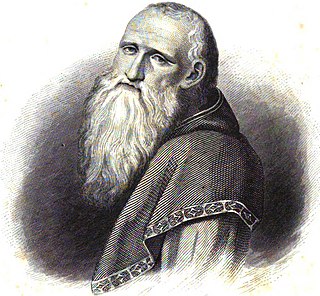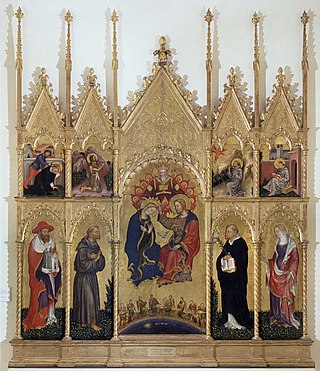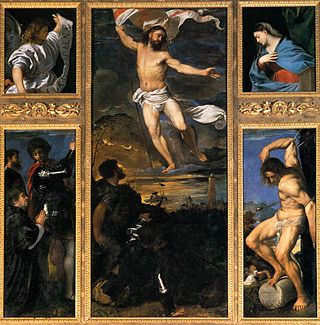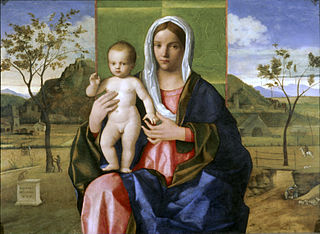
Andrea Mantegna was an Italian painter, a student of Roman archeology, and son-in-law of Jacopo Bellini.

Lorenzo Lotto was an Italian painter, draughtsman, and illustrator, traditionally placed in the Venetian school, though much of his career was spent in other north Italian cities. He painted mainly altarpieces, religious subjects and portraits. He was active during the High Renaissance and the first half of the Mannerist period, but his work maintained a generally similar High Renaissance style throughout his career, although his nervous and eccentric posings and distortions represented a transitional stage to the Florentine and Roman Mannerists.

Pietro Perugino, born Pietro Vannucci, was an Italian Renaissance painter of the Umbrian school, who developed some of the qualities that found classic expression in the High Renaissance. Raphael was his most famous pupil.

Bernardino Luini was a north Italian painter from Leonardo's circle during the High Renaissance. Both Luini and Giovanni Antonio Boltraffio were said to have worked with Leonardo directly; he was described as having taken "as much from Leonardo as his native roots enabled him to comprehend". Consequently, many of his works were attributed to Leonardo. He was known especially for his graceful female figures with elongated eyes, called Luinesque by Vladimir Nabokov.
Andrea Solari (1460–1524) was an Italian Renaissance painter of the Milanese school. He was initially named Andre del Gobbo, but more confusingly as Andrea del Bartolo a name shared with two other Italian painters, the 14th-century Siennese Andrea di Bartolo, and the 15th-century Florentine Andrea di Bartolo.

Giovanni Battista Cima, also called Cima da Conegliano, was an Italian Renaissance painter, who mostly worked in Venice. He can be considered part of the Venetian school, though he was also influenced by Antonello da Messina, in the emphasis he gives to landscape backgrounds and the tranquil atmosphere of his works. Once formed his style did not change greatly. He mostly painted religious subjects, often on a small scale for homes rather than churches, but also a few, mostly small, mythological ones.

The Pinacoteca di Brera is the main public gallery for paintings in Milan, Italy. It contains one of the foremost collections of Italian paintings from the 13th to the 20th century, an outgrowth of the cultural program of the Brera Academy, which shares the site in the Palazzo Brera.

Altobello Melone was an Italian painter of the Renaissance.

Santa Maria presso San Satiro is a church in Milan. The Italian Renaissance structure (1476-1482) houses the early medieval shrine to Satyrus, brother of Saint Ambrose. The church is known for its false apse, an early example of trompe-l'œil, attributed to Donato Bramante.

Giuseppe Vermiglio was a Caravaggist painter from Northern Italy, active also in Rome.

The Abbey of Santa Maria di Rovegnano is a Cistercian monastic complex in the comune of Milan, Lombardy, northern Italy. The borgo that has developed round the abbey was once an independent commune called Chiaravalle Milanese, now included in Milan and referred to as the Chiaravalle district.

The Valle Romita Polyptych is a painting by the Italian late Gothic painter Gentile da Fabriano, dating from c. 1410-1412 and now housed in the Pinacoteca di Brera in Milan. It was originally executed for the Franciscan hermitage of Valle Romita near Gentile's birthplace, Fabriano.

Giovanni Agostino da Lodi was an Italian painter who was active from c. 1495 to c. 1525.

The Averoldi Polyptych, also known as the Averoldi Altarpiece, is a painting by the Italian Renaissance painter Titian, dating to 1520–1522, in the basilica church of Santi Nazaro e Celso in Brescia, northern Italy.

Pietà or The Dead Christ Supported by the Virgin Mary and St John the Evangelist is a c. 1465–1470 tempera on panel painting by Giovanni Bellini, now in the Pinacoteca di Brera in Milan.

The 'Madonna and Child or Madonna with the Christ Child Blessing is a 1510 oil on panel painting by Giovanni Bellini, painted when he was already in his eighties but still responding to new developments in painting. It is similar to the 1505 Madonna del Prato and the 1509 Madonna and Child. It is now in the Pinacoteca di Brera in Milan.

The Greek Madonna is a 1460–1470 tempera on panel painting by Giovanni Bellini. It is named after the Greek monograms at top left and top right and after the major influence of Byzantine icons on the painting. The Christ Child holds a golden apple, perhaps referring to the Judgement of Paris and to Mary as the "new Venus".

The San Domenico di Pesaro Altarpiece is an oil-on-panel painting created ca. 1524–1526 by the Italian Renaissance artist Giovanni Girolamo Savoldo, now in the Pinacoteca di Brera, in Milan. The work dates to the same period as Savoldo's Rest on the Flight into Egypt, also produced for San Domenico. It shows the Madonna and Child seated between two angel musicians, while in the lower register it shows Saint Peter, Saint Dominic, Saint Paul and Saint Jerome.

Madonna of the Rose Garden is an oil painting on panel of c. 1510 by the Italian Renaissance artist Bernardino Luini. It is in the Pinacoteca di Brera in Milan, which acquired it from the Giuseppe Bianchi collection in 1826.

The Adoration of the Magi with Saint Helena is an oil painting on canvas of c. 1525–1526 by Palma Vecchio in the Pinacoteca di Brera, Milan.



















